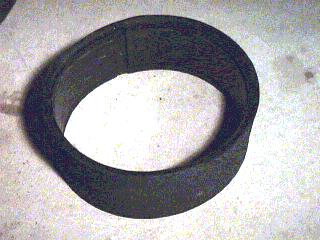| Forum | Marketplace | Knowledge Base | | H1 site | H2 site | H3 site | |
The Hummer Knowledge Base
|
> From: Mark Doucette: > > The hummer rims have a ring (I am talking 2 piece wheels here) that fits > on the inside of the tire, when you bolt the rim together it squishes > the rubber bead of the tire to the rim lip (I know you already know this > but...) Hummers have beadlocks with runflats as one piece or just > beadlocks as well as other combinations. A standard beadlock (that I am > used to) has a series of bolts on the outside of the rim that holds a > ring on to the rim (you have to weld threaded pieces to the inside of > the rim) This outside ring is actually the bead lip on a normal rim, > but now it is removable. When you put this outside ring on, you > compress it to the rim and this holds the tire from spinning on the rim, > it is almost impossible to get the tire to spin on the rim with no > pressure, unlike the Hummer beadlocks which can allow the tire to spin > on the rims a small amount. Excellent post Mark. Another way of visualizing the beadlocks is to think of how a tire is on a normal rim. There is nothing on the inner side of the bead. So imagine a stop for the bead on that side. The bead butts up against it like the way the tire butts against the rim flange on a normal rim. This inner lip is part of the rim. So how do you install a tire? Well, the piece that forms the outer rim flange bolts on and off. You mount the tire sort of like usual except that the outer bead rests on this inner flange. The bead is fully exposed to the outside. You then install the outer ring and bolt it to the rim. The bead gets squished between the two rings and really holds it in. Beadlocks exist for two reasons. The first, as Mark states, is to prevent the tire from spinning on the rim. Most important for racing where you have high traction and lots of power. The second function is to retain the bead on the seat so that it does not slide off. This is what we care about off-road. As Mark explains, the stock beadlock or beadlock/runflat on a two piece rim protects and holds both the inner and outer beads. While it does not prevent spinning, it makes it pretty improbable with stock tires. Happens mostly from a spinning wheel catching traction. With non-stock tires, the beads are thinner so the runflat/beadlock does not hold as well to prevent spinning, but prevents unseating. The new beadlock/runflat on the 1 pc rims protects only the inner bead. IMHO, you lose the outer bead much more often. The bolt on beadlock for off-road use is normally only on the outside of the rim, where you need it. The next question is can you add a bolt on bead lock for the 1pc rim? The simple answer is no. For some reason, the bead widths on 16.5 tires vary alot. You have to know this to make the beadlock. So you can do it for one type of tire only. However, it may work just fine on other types. I don't know if you could still use the runflat/beadlock device. Now if you go to 17", you can easily get a beadlock. In talking with rim manufactures, they suggest not trying to do the beadlock with the 16.5 They say go to 17. There are not many 17" truck tires yet (there are rumors).
> that I can scan for you if you would like to see them. The alum. rims > that we have heard about lately (not the 17" ones) have no beadlock, > just what the call a safety lock which is a second bump in the rim lip > area which will hopefully hold the tire on in case of a deflation (don't > plan on this bump keeping the tire on in a severe off road condition > with low pressure) Excellent point. The safety bead is pretty small. It is more like a normal (non-16.5) bead seat area. Remember that AMG thought it necessary to always have beadlocks with CTIS vehicles. Gerald
|

